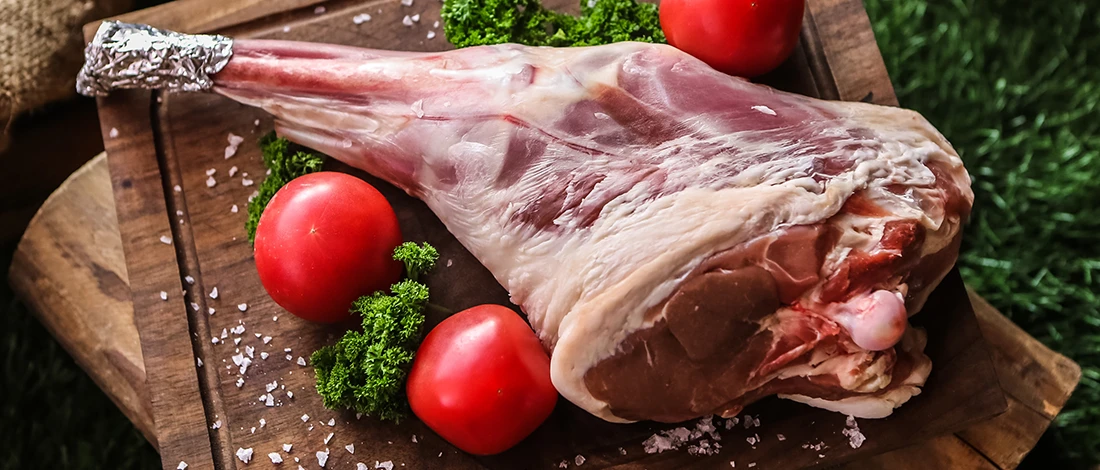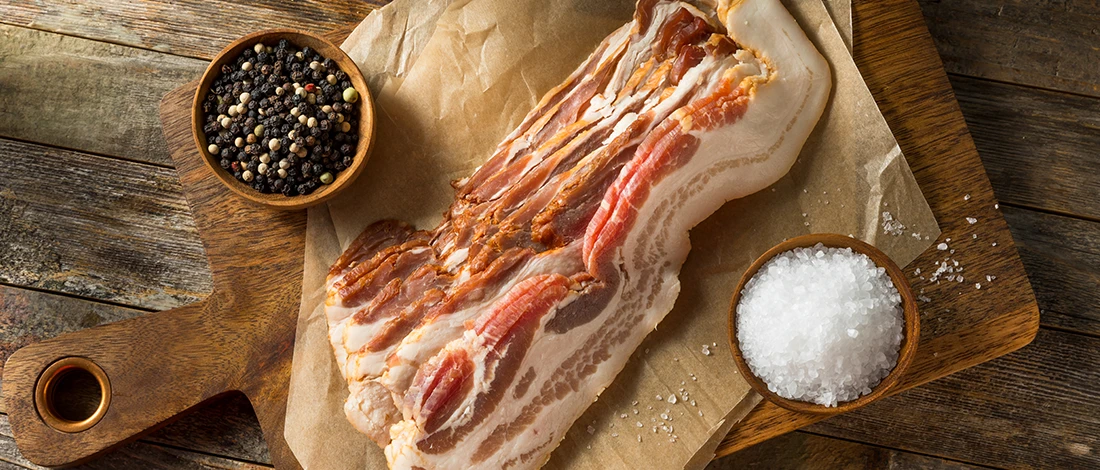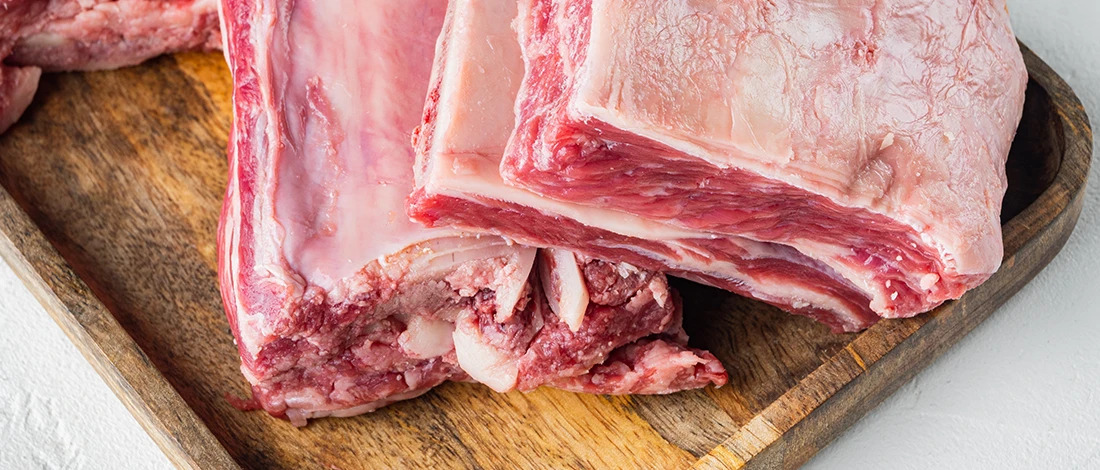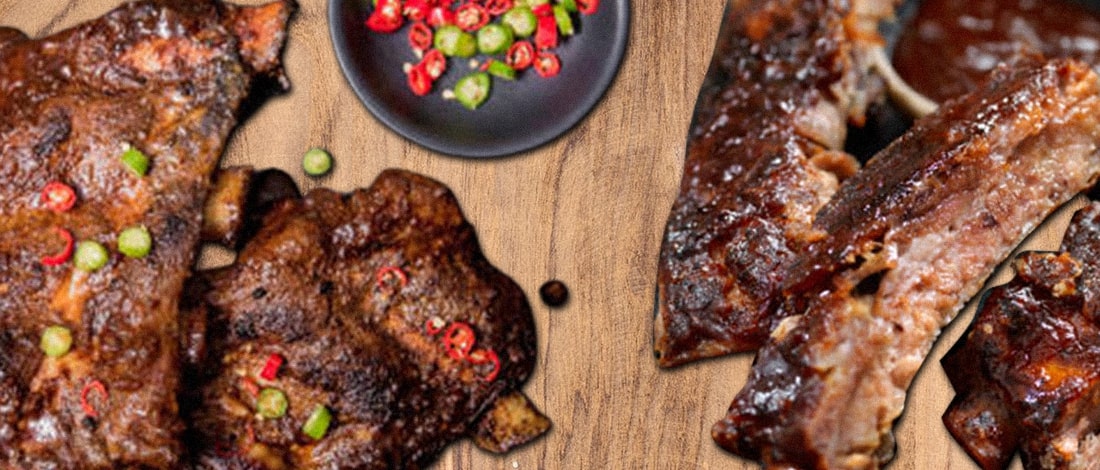I’ve been on a carnivore diet for over a decade, and I’ve eaten all kinds of meat during this time, but veal and lamb are among my favorites. I usually eat veal or lamb at least once a week.
I talked with a butcher to learn everything about these two kinds of meat, from origin, taste, and texture, to the best cooking methods.
Today, I’ll explain every difference between veal and lamb and give you my tips on shopping for these juicy cuts.
Quick Summary
- Veal is meat from calves and lamb comes from young sheep.
- Veal tastes similar to beef and has a neutral flavor while lamb has a gamey taste and is more intense than veal.
- Lamb is usually cooked to a medium level, but veal is best grilled or broiled.
Veal and Lamb Meat Source

Veal and lamb meat are sourced from different animals, which can explain the differences in their characteristics.
Buying from trustworthy sellers is one way to ensure you get quality lamb and veal meat. ButcherBox is an online meat delivery service that sells high-quality meats.
About Veal
Veal is meat that comes from calves. The difference between beef and veal is that beef comes from mature cows, while veal comes from a calf — a cow that hasn’t reached maturity.
Specifically, veals usually come from young males bred in dairy cow families. Dairy cows are used for milk, but a male can’t produce milk, so it’s used for veal instead. Veal is sourced from calves that weigh between 150 to 350 lbs.
Veal is considered specialty meat. Calves are smaller than adult cows, so they have less meat. This means veal is less common than beef.
Veal meat is a lighter color than beef and resembles pork. In terms of value, veal is more expensive than beef, and Australia is best known for producing quality veal.
About Lamb
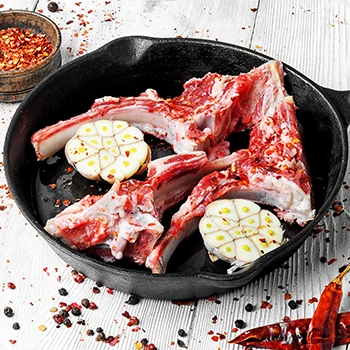
While lamb comes from young calves, lamb comes from young sheep.
Note: Don’t mistake all sheep meat for lamb. Mutton is meat from adult sheep, and lamb comes exclusively from young sheep.
Lamb meat is also considered a specialty because it comes from sheep aged between 12 to 14 months [1].
There’s officially no weight rule for lamb, but the most common weight for a lamb is between 12 lbs to 66 lbs.
Same as veal, lamb is very tender meat. Shanks and legs are the most common lamb cuts because they have the least amount of fat and the highest amount of protein. Neck, flank, loin, ribs, and breast are also used.
Lamb is produced in Australia, New Zealand, India, China, Algeria, and the UK, with Australia and New Zealand being the biggest lamb producers.
Lamb meat is pink or reddish in color.
Read more: Is Lamb Red Meat?
Veal vs. Lamb Meat Compared
Here are the main differences between veal and lamb.
1. Taste
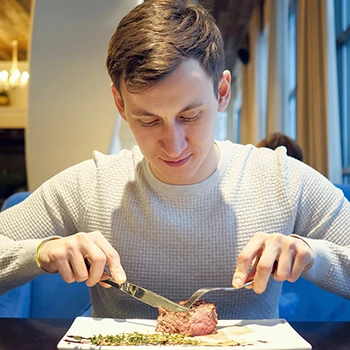
Lamb meat has a stronger and gamier taste compared to veal meat. This is because lamb has a type of fatty acid that veals don’t.
Lamb is tender but still firm and has a more potent taste with a gamey flavor. It can be eaten on its own and has a slight sweetness. However, this mostly depends on how lamb is cooked and raised.
American-raised lambs are usually grain-fed, while lambs in other countries, for example, Australia, are usually grass-fed. Grain-fed lambs don’t have the same amount of fatty acids as grass-fed meat ones, so their meat is milder.
Veal tastes similar to beef. However, veal meat comes from calves, not cows. Calves have undeveloped muscles, so their meat is more tender than beef but not as tender as lamb.
Veal also has a more delicate and neutral flavor compared to lamb. Overall, veal is beef with a less aggressive flavor. Some people find the taste of veal meat too bland, so spices, marinades, and sauces are commonly used to add flavor.
Note: The breed, conditions in which the animals were raised, and the cut of the meat determine both veal and lamb’s texture and taste. The conditions in which their mothers were raised also contribute to the taste.
The flavor of the veal also depends on whether the animal was formula-fed, milk-fed, or non-formula-fed. Finally, it matters if the animals were raised in pastures or cages. All of this influences the nutrition, texture, and meat taste.
If you can, talk with your butcher or online butcher service to find out more about the meat’s origin.
To sum up, you’ll love the taste of lamb if you’re into deep, gamey flavors. You’ll love veal if you’re into the less intense flavor.
2. Cuts
The most common cuts of veal are:
- Chuck
- Brisket
- Shank
- Breast
- Rib
- Sirloin
- Short loin
- Short plate
- Flake
- Round
There’s also bob veal, which are cuts of veal from the meat of a calf less than one-month-old.
The most common cuts of lamb are:
- Square cut shoulder
- Rack of rib
- Loin
- Leg
- Neck
- Breast
- Flank
- Shank
Legs and shanks are considered the best cuts of lamb.
Note: You can substitute some cuts of veal for lamb and vice versa when cooking. However, keep in mind the lamb taste is stronger than veal and can change the dish’s composition.
3. Cooking
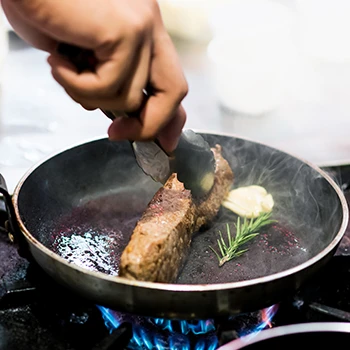
Lamb is usually cooked to a medium level. For example, you’ll often find lamb cooked medium if you go to a restaurant.
This especially goes for lamb chops which are the most popular lamb dish in the USA.
Of course, this is a matter of preference, and you can cook lamb to whatever doneness you like.
For example, Gordon Ramsey recommends cooking lamb by searing it and then basting it with herbs with garlic butter. Then finish the lamb in the oven.
“Ask the butcher to French trim your lamb. Lightly season it with salt and pepper. The secret behind cooking lamb, especially quality lamb, is in the actual searing.”
- Gordon Ramsey, Chef, MasterClass YouTube Channel
Also Read: Lamb Roast Recipe
The most popular lamb dishes are:
- Seasoned lamb chops
- Roasted lamb with potatoes
- Rack of lamb
- Lamb burgers
- Lamb kebabs
- Moussaka
- Shredded lamb shoulder
- Lamb soup
- Mongolian lamb stir fry
- Lamb meatballs
- Souvlaki
- Lamb gyros
- Moroccan lamb tagine
- Slow-roasted Persian lamb
Lamb is commonly used in Mediterranean and European dishes. For example, it’s heavily featured in Greek cuisine, where it’s usually well-cooked, while it’s served rare in France.
Tip: Use savory seasonings and glazes. Lamb is extremely tender, so these work well with lamb meat.
Veal is also commonly used in Mediterranean cuisines, especially Italian and French. These cuisines usually have cutlets.
However, veal can be served in other ways, such as:
- Grilled veal
- Stew
- Veal parmigiana
- Roasted veal with mushrooms
- Veal Marsala
- Pot roast
- Breaded veal cutlets
- Steaks
- Veal chops
- Veal burgers
- Veal piccata
- Veal pot roast
Veal works best paired with dishes that have a light flavor. Veal bones are great for making stock, soups, and sauces.
Tip: Use wine or wine sauces when cooking veal.
The two most common methods of cooking veal are moist or dry heat. Veal steak, chops, and tenderloin should be cooked using dry heat, which means grilling, broiling, or pan-searing.
You’ll know your veal and lamb are done when the internal temperature reaches 145 degrees. The meat should be slightly pink in the middle. The internal temperature for ground veal and ground lamb should be 160 degrees [2].
4. Nutrition
4 oz servings of lamb have around 330 calories, while the same amount of veal has about 260 calories. Lamb has more fat — 20g, while veal has 13g, which means veal meat is much healthier [3] [4]. Moreover, the fat in veal is less saturated, so veal has a better profile.
In terms of protein, veal is the winner again. It has 34g of protein, while lamb has 28g.
Both veal and lamb are rich in vitamins, but lamb has higher amounts of Vitamin K, iron, and nine times vitamin b12.
Veal has more cholesterol and three times the amount of vitamin B6 than lamb. It’s also richer in vitamin B5.
Overall, lamb is more nutritious than veal, and both kinds of meat have less fat than beef and sheep.
Tips for Buying Veal and Lamb

Always check the meat origin when buying veal and lamb because Australian lamb has a gamier taste than American. This is because Australian lamb is grass-fed.
Choose lamb that’s light red or dark pink. If the meat is dark red, it’s a sign the sell-by date is gone. This meat is still safe, but it'll lack flavor.
Buy veal that’s pink and has bright white fat. If the veal is red, it’s a sign the animal is older, so the meat won’t be as mild in taste or as tender.
Avoid buying veal and lamb meat that’s gray or has a lot of juices underneath the meat.
The most common lamb meat you can buy in grocery stores is rib chops, bone-in or boneless leg of lamb, sirloin, and shanks.
On the other hand, veal is more difficult to find, and the most common available cuts are usually veal chop, ground veal, and cutlets.
“The first thing you have to think about with veal is that you get the tender and delicious quality. Veal is preadolescent beef. It’s only five to twelve weeks old, which means it’s under three months. Best quality is pale, whitish pink, slightly pinker than raw chicken.”
- Julia Child, Chef, Julia Child on PBS, YouTube Channel
Another tip is to talk with your butcher before buying lamb and veal, especially veal. Ask if the veal meat is light or heavy. Light veal is better for roasts, schnitzels, and grilling. This veal meat is more delicate in texture.
Heavy veal is best braised or used in a stew. It has a stronger taste and is good low-simmered. This brings out the veal's flavor.
Related Articles:
FAQs
Is Veal Better Than Lamb?
Whether veal is better than lamb depends on what kind of flavor you like. If you like mild and tender meat, go for veal, but if you like a stronger flavor, choose lamb. Also, veal meat is better if you're on a diet because it's leaner and has less saturated fat.
Why Is Lamb Okay But Not Veal?
Lamb is okay but not veal because calves are killed to be eaten around 14 weeks of age. Lambs are killed anytime before they turn a year and are allowed to live normally in the fields, so some people believe eating veal is crueler.
Is Veal a Cow or Lamb?
Veal is a cow, not lamb. Specifically, veal is meat from calves of either sex, but most commonly from young male calves. Cow meat comes from adult cattle.
Does Veal Taste Like Lamb?
No, veal doesn’t taste like lamb. Lamb has a slightly gamey flavor, and veal tastes like beef but milder.
Why is Veal so Expensive?
Veal is so expensive because there are higher production costs and a lower output compared to output from older cattle.
Is Veal Healthy to Eat?
Yes, veal is healthy to eat. 3 oz of veal has over 10% of the daily values of protein, zinc, niacin, and vitamins B12 and B6.
References:
- https://www.ers.usda.gov/topics/animal-products/sheep-lamb-mutton/sector-at-a-glance/#
- https://www.usda.gov/media/blog/2022/10/03/cooking-meat-it-done-yet#
- https://www.nutritionix.com/food/lamb
- https://www.fatsecret.com/calories-nutrition/generic/veal-cooked-ns-as-to-fat-eaten?

